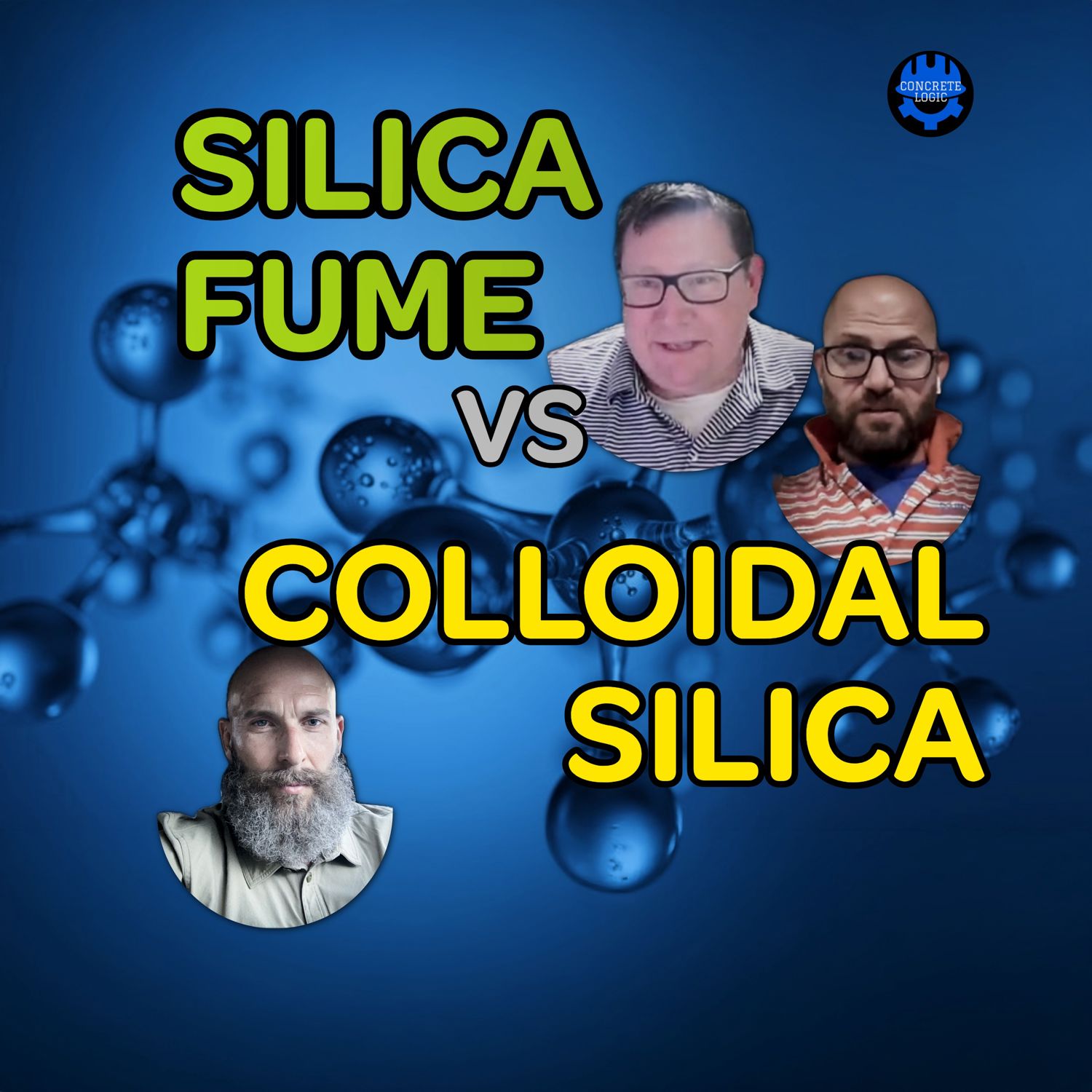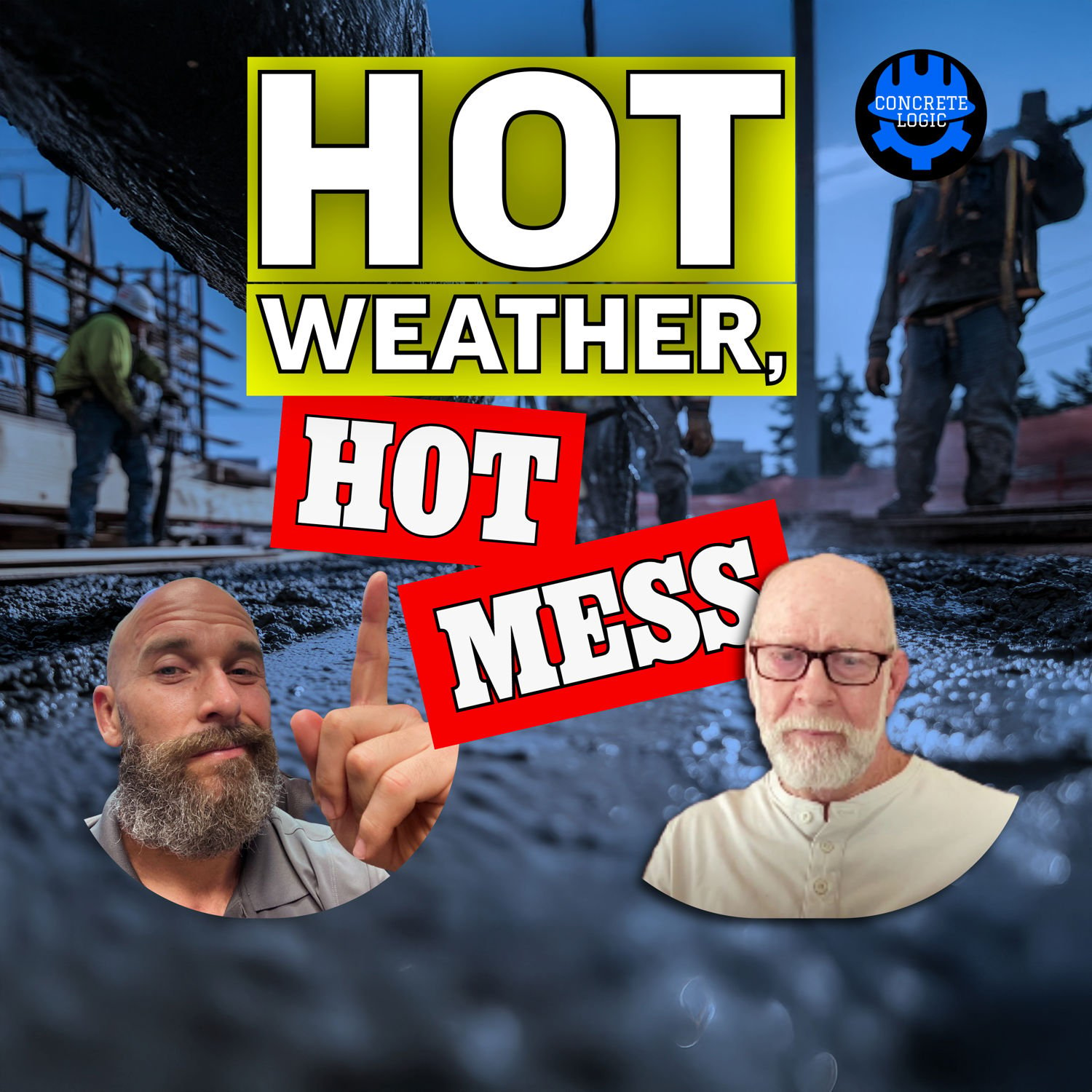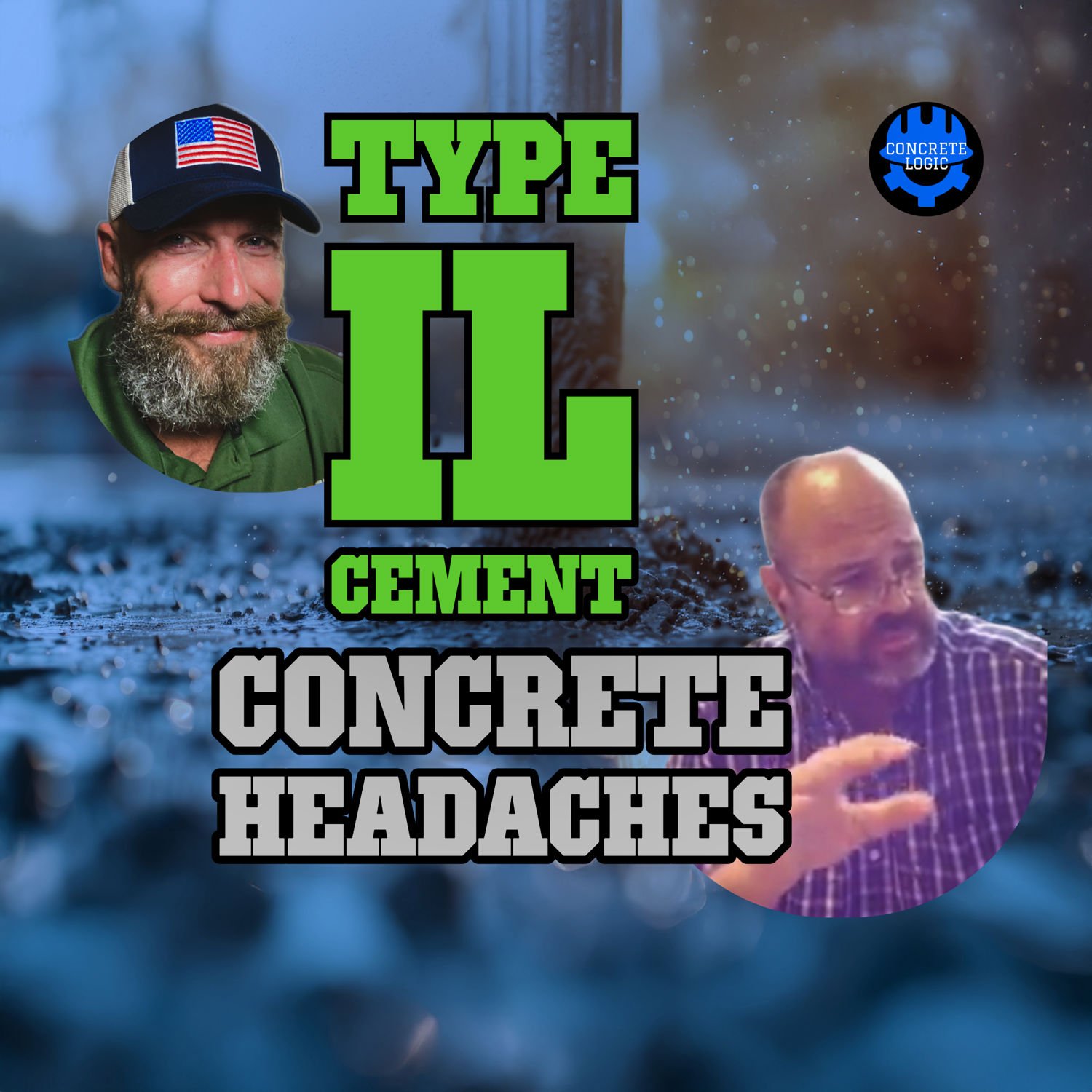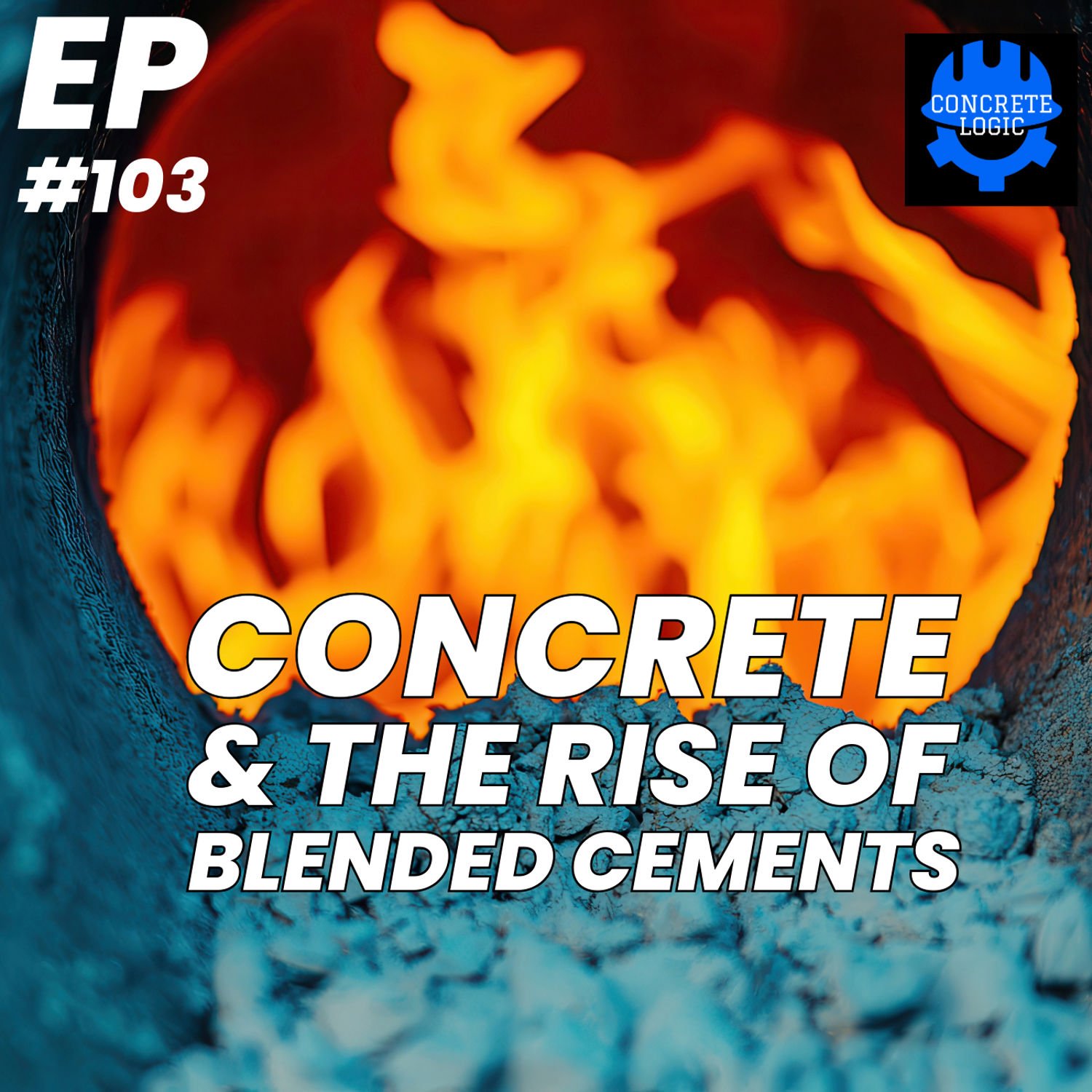EP #109: ACI 323, The Fast-Approaching Code and Its Impact on Concrete
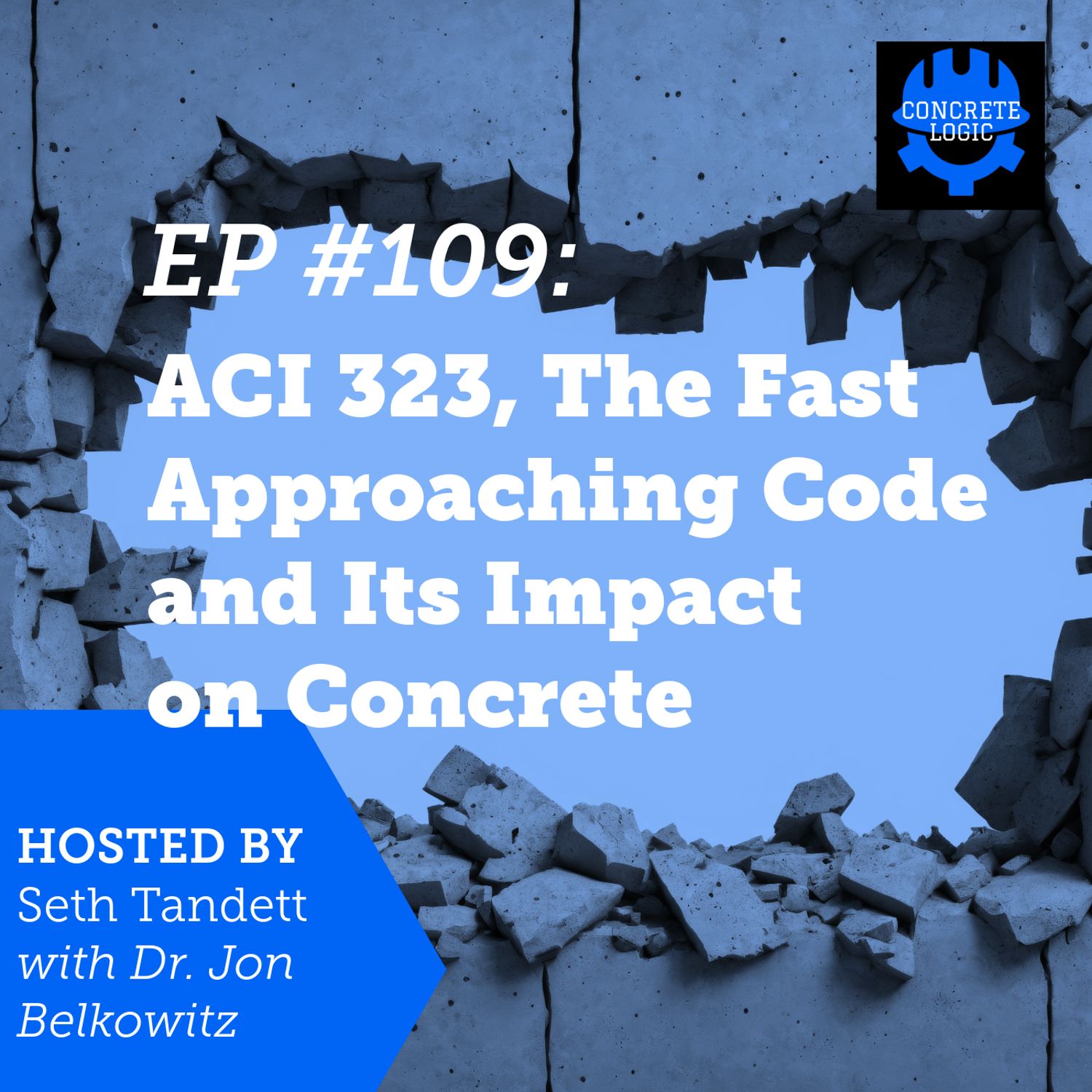
In this episode of the Concrete Logic Podcast, host Seth Tandett is joined by Rich Szecsy and Dr. Jon Belkowitz to discuss the recently released ACI 323 code on low carbon concrete. The trio dig into the significance of the code, the confusion surrounding its implementation, and the challenges it poses for ready-mix producers and construction practices. The hosts explore the implications of the new code on concrete pumping, the role of authorities in code adoption, and the need for future updates to adapt to evolving industry standards. The episode concludes with reflections on the potential impact of the code and the importance of ongoing dialogue in the concrete industry.
Takeaways
- ACI 323 represents a significant shift in concrete standards.
- The code's implementation may create confusion for industry professionals.
- Ready-mix producers face challenges in meeting new low carbon requirements.
- There is a need for clarity on the authority of jurisdiction in code adoption.
- Frequent updates to the code will be necessary as more data becomes available.
- The relationship between contractors and ready-mix suppliers is crucial for compliance.
- Concrete pumping practices may be adversely affected by the new standards.
- Policymakers will likely default to adopting ACI 323 without fully understanding its implications.
- Ongoing discussions are essential to navigate the complexities of low carbon concrete.
Chapters
00:00 Introduction to the Concrete Logic Podcast
03:17 Overview of ACI 323 and Its Significance
06:47 Confusion Surrounding Low Carbon Concrete Standards
09:21 Challenges in the Concrete Supply Chain
12:51 The Role of Authorities in Code Adoption
20:42 Impact of Low Carbon Concrete on Local Regulations
28:35 Future Updates and Adaptations of ACI 323
30:01 The Need for Frequent Updates in Concrete Codes
32:02 The Evolution of Low Carbon Concrete Standards
33:50 Challenges in Concrete Production and Compliance
38:55 Confusion Surrounding Concrete Codes and Specifications
48:59 The Impact of Policy on Concrete Standards
51:58 Looking Ahead: Future of Concrete Codes and Practices
***
Did you learn something from this episode? Would you like to support the concrete industry's favorite podcast?
If so, donate at https://www.concretelogicpodcast.com/support/ .
When YOU donate to the show, you will be listed as a producer of the next episode that is released!
Join the Concrete Logic Academy! Enhance your learning from our podcast with engaging quizzes that test your knowledge and help you earn Professional Development Hours (PDHs).
Support Concrete Logic and take your education to the next level! 🚀
FIND OUT MORE HERE: https://www.concretelogicacademy.com/
***
Episode References
Guest: Rich S. Szecsy, PhD, PE, FACI | Big Town Concrete | rich@bigtownconcrete.com
Guest Website: https://www.bigtownconcrete.com/
Guest: Dr. Jon Belkowitz | Intelligent Concrete | Jon@intelligent-concrete.com
Guest Website: https://www.intelligent-concrete.com/
Producers: Mark Liebert, Jodi Tandett
Donate & Become a Producer: https://www.concretelogicpodcast.com/support/
Music: Mike Dunton | https://www.mikeduntonmusic.com | mikeduntonmusic@gmail.com | Instagram @Mike_Dunton
Host: Seth Tandett, seth@concretelogicpodcast.com
Host LinkedIn: https://www.linkedin.com/in/seth-tandett/
Website: https://www.concretelogicpodcast.com/
LinkedIn: https://www.linkedin.com/company/concrete-logic-podcast
Why join the Concrete Logic Academy?
You get access to:
- Hands-On Video Courses: Dive into one of our many educational video courses. Each course breaks down complex topics related to concrete construction into easy-to-understand modules, accompanied by visuals. These knowledge-packed materials not only enrich your understanding but also make it enjoyable and engaging.
- Live Q&A Sessions: Attend our exclusive live Q&A sessions. Every session is hosted by industry leaders with years of expertise in concrete construction. These interactions provide opportunities to get your queries addressed in real-time, fostering a deeper understanding of the subject.
- Collaborative Projects: Take part in our groundbreaking collaborative projects. Here, you get to apply the knowledge you’ve gained from the courses and Q&A sessions, work with other community members, and create innovative solutions for the concrete industry. Experience the satisfaction that comes with problem-solving and contributing to the industry.
- Live Podcast Recordings: Experience the thrill of live learning by joining exclusive, real-time recordings of the Concrete Logic Podcast, where industry leaders unveil cutting-edge insights and groundbreaking innovations.
- Concrete Library: Access eBooks, Expert Articles, Academic Papers, and Industry Archives. These resources propel your learning journey, offering knowledge tailored to students, researchers, and professionals.
- Dynamic Growth Hub: Secure your spot at today's membership price in the ever-growing Concrete Logic Academy, where you'll gain access to an expanding library of courses, publications, and resources. Join now and benefit from our continuous growth before prices rise!
Learn more: https://www.concretelogicacademy.com/
Seth Tandett (00:01)
All right. here we go. Another episode of the concrete logic podcast. And today I got the dynamic duo, back, rich Sagey and Dr. John Belkowitz. Wait, what's the face for?
Rich (00:11)
Thank
Dr Jon (00:17)
I thought our nickname was the reading trio.
Rich (00:21)
You
Seth Tandett (00:21)
reading trio for this? Well, cause we're, we have a book club that we're going to talk about today. We're ACI three 23. Yeah. we, we, I mentioned it to, by the time this comes out, y'all have, heard from, Mr. Colin Lobo. And I kinda, we, we, we kinda talked a little bit about this new code. but today we're going to really talk about it.
Dr Jon (00:23)
Like all three of us. Yeah. Like what?
Rich (00:24)
you
Hahaha!
Dr Jon (00:31)
Woo woo!
Seth Tandett (00:51)
but before we get started, just remind everybody how you can support the podcast. go do, if you, if you get something out today and I, you certainly will, because I've already asked people if they've read this code yet and 99 % said no. So you might. Yeah. anyhow, and, if, if you get something out of the episode today, please, please share this podcast, episode with a colleague or coworker.
And let them know that this thing's out there The next couple things that you can do is if you go to concrete logic podcast comm There are two ways to get a hold of me There's a contact button on the top of the page and then in the lower part of the page right hand side There's a little microphone icon there you So you either click on one or the other if you want to shoot me an email click on the contact button if you want to do a voicemail
click on the microphone and what we're looking for is topic or guest suggestions. Tell me what you want to hear on the podcast. Otherwise I'm going to keep. So which is not a bad thing, I guess. and then the last way you can do is on the same homepage, there's a donate button. So if you, get some value out of the podcast, think of how much that's worth to you.
and can click on that donate button, send that over to me, help the podcast, make it better. And then recently, new, a new way you can get involved. If you're really passionate about concrete, there's another way you can get involved with us. It's the ConcreteLogicAcademy.com. Go over there, join, and you can actually sit in and shoot me your questions during a podcast, because we're doing these live now.
jump in there and, and, say, Seth, ask this question or Hey Seth, you don't know what you're talking about. I don't care. Just get in there and get involved. That's all I care about. so yeah, so that's it for that. So let's get the topic at hand. I was telling Rich and Dr. John how I was struggling this morning. Every time you buy ACI code, I got to go in here and put it.
damn license number in there. It irritates no end to me. So if someone knows how to fix that, let me know. But anyways, today we're going to talk about the low carbon concrete code requirements and commentary on ACI 323. So if you all didn't know, this was released recently and I wanted to bring Rich and Dr. John on to give their initial thoughts.
And yeah, so that's what we're going to talk about today. Rich, should we just let the valve open the valve on Dr. John and then we jump in?
Rich (03:54)
Well, so let's talk about the big picture first. So ACI has undergone two big changes in the last couple of years. And the first is that reference to on the very first page, you'll see the word code, right? So that is now part of their title. And that didn't used to be there. So I think it was about two years ago, December, two years ago, they made that change to where that's now part of the title.
Dr Jon (03:56)
you
Seth Tandett (04:02)
Okay.
Rich (04:23)
The other thing is with 323, a very big committee formed and released that. this was, so one, John and I are gonna talk about this. We're gonna agree to disagree on a couple of things, which I think Seth is why you always bring us on here. ACI got this done in a very short time period. And I'm gonna use short as a relative term because the comparative to that would be say ACI 211 on mixing and batching.
The last number on that was 91, and that took 30 years to update. So I want you to just understand 31, the comparison between the two. So this 323 didn't take 31 years to develop. It happened in very, very quick time frame relative to other ACI documents to update that have been well established for decades. So just as a...
Dr Jon (04:58)
31. Yeah.
Rich (05:20)
why this is such an important document and at the speed at which this document was produced and released. That's big picture global. And I'm not speaking for ACI. I'm just telling you as a consumer of ACI documents, how stark the contrast was because we had been waiting for ACI 211. Guys update, update, update. Now again, these are all people. Most of these people who are on these committees are my friends, John's friends. We know these people. They do good hard work. Yes.
Dr Jon (05:46)
Good people.
Rich (05:49)
It just takes time. 323 in comparison was light speed compared to the glacial pace that 211 did. I'm not saying that disparagingly, I'm just saying it as a contrast. So that's a big picture. And the other thing I'll tell you is right now, in the absence of any document, 323 is now the only place for what I would call a published document that you can go to that
has applicability for the area of low carbon global warming potential to be addressed. So we're gonna talk about the details and some of the things that we have thought about and found in there, but big picture, this is what we have now and everything will be based or referenced back to this. So that's my big, that's my global picture. John, what did I get wrong on that?
Dr Jon (06:43)
There's not a lot of people. There's 15 people in this committee, at least on this thing. And not a lot of them, and this is where I'm skating the line of an ad hominin, not a lot of them have concrete manufacturing experience.
And this is, you know, I'd like to start off by saying, you know, Seth asked, what did we think of this overall? Overall, this is confusing. You know, I don't want to, I don't want to take one of Rich's sayings right now, but I don't know if it was confusing by accident or on purpose. Right? It's very confusing. I don't know if it's more important for me as somebody who designs concrete.
does quality management systems for ready-mix providers. I don't know if it's this is more important. I don't know if ACI 214 is more important or ASTMC 94 is more important, especially when it comes to over-design. So what I'm going at, just going back to the overall, I think this is going to suck for ready-mix producers, rich, licensed design professionals, which somehow includes architects and engineers.
I don't know how that makes sense. then concrete pumpers. The dichotomy between having an extremely low carbon GWP, the kilogram CO2 equivalent per cubic yard for 4,000 PSI, sorry, 4001 PSI and a 5,000 PSI, I mean, to get to that same number, according to this, the only way you could do that is aggregate.
with the administration, you know, that you have to keep the records. This is going to be a nightmare for everybody. I don't think this is the same thing. That's the other thing I wanted to argue. You guys didn't see what was different. I see that it's going to be harder to pump concrete, especially that, well, I'll get into that later. And then the accounting of all this is just going to be a pain in the ass, especially if you have to go to some unknown entity called.
the authority of jurisdiction, which I already...
which I already asked for what the hell that means. I think this is gonna make making and transporting concrete much tougher.
Rich (09:21)
Yeah, I think you almost to start, you got to work backwards along the value chain, right? So you've got an owner who wants a result. They hire a general contractor who hires a subcontractor that hires a ready mix producer, right? So let's just call it that the traditional value chain along there. At some point that owner from a design team standpoint wants a result and let's just use global warming potential or GWP.
as the acronym, is going to say, hey, I want to achieve this level. And then they're gonna, the design team, architects, engineers are gonna say, this makes sense. And then they're gonna hand that down that food chain. And I think, John, you're absolutely right. At the bottom of that food chain, you have the ready mix supplier, but now I am directly going to be engaging my material suppliers on the powder side, on the aggregate side.
all who are now part of this because the only document prior to this being released was nothing. It was included in the contract documents that somebody may have quite literally either copied or made up or they were referencing an RMCA or these kinds of things. All good places, but there was no formality or consistency. At least here with 323, it's kind of like if we asked the three of us to write a letter.
We would spend the next three weeks going back and forth, back and forth, writing a letter. Or I could write the letter and then ask the two of you guys to help me edit it. I kind of am approaching it a little bit of that way of like, there's something that's been written and now we have the ability to help edit it from a practical standpoint when it hits, when we get to, know, John, you know, I love my three concrete concretes, the real Crete. We're gonna have to edit this in practice.
Dr Jon (11:18)
Okay, I get it, but it's a code. It's a code. This is not the time to edit it to the point of four strength should have a space between four and strength and identifying the most important person in this wonderful ACI code. You see how I saved that one there? I almost said some bad words.
Rich (11:41)
It was nice. It's very nice. Nicely done.
Dr Jon (11:45)
Like I just think this was quick. I can't decide if this was quickly written. I understand the value chain. It's going to suck somewhere. I can't understand why this was written, why this had to become a code. Like I'm, I'm, I'm, I'm addressing this as I would ACI three 18 ACI two 14. Like
Rich (12:08)
Yeah, I think that's the proper approach.
Dr Jon (12:13)
Okay, well then there's something in here that tells you...
Rich (12:14)
So, and I also think you're going to see this.
I think you're gonna see this show up in MasterSpec if it hasn't already, but I would be shocked if this wasn't adopted into MasterSpec or some of those other ones. So when we wind up pulling section 03300 of the contract documents and on the first two pages where it references ACI codes and ASTM standards, this is now just listed there as a default document. And I think you're gonna start to see that whether the project or not,
Dr Jon (12:47)
Okay, so.
Rich (12:51)
has a focus on low-carbon concrete.
Dr Jon (12:55)
So if the project has a low carbon or a focus on low, so this is a question for you, Rich. And then I really want to go into why I don't like this thing. I want to be cut and dry about that, but you are, you are a ready mix provider. Hey, you know, I I've learned that when ACI it's like a four year old, when my four year old wants a snack at 7 PM at night, watch the out.
Like it's the same thing with when they want to publish something, whether or not it makes sense, they're going to fricking publish it. And to me, this doesn't make sense. And one of the things that doesn't make sense is on page five, it's commentary R1.61. It's the third to last sentence where it says, for instance, specifications requiring minimum, semantitious contents.
the exclusion or limitation of supplementary cementitious material and mixture requirements of 1200 PSI over design will reduce the flexibility needed by the concrete supplier to meet specified GWP limits. What the hell does that mean?
Rich (14:14)
that's my get out of jail free card. That's when I see, that is when I see a specification that comes through that says minimum 500 pounds of cementitious material or minimum 600 pounds of cementitious material with my over design. I don't have to hit the GWP limit because somebody has specified a minimum requirement. There's examples of those kinds of things in practice all over the place.
Dr Jon (14:30)
Right.
Okay.
Rich (14:44)
Let's take Marin County, California, which is being used as an example of registering low carbon concrete. When you dig into theirs, if you designate anything as high early strength, it doesn't matter. And of course, know, Seth, what project have you ever worked on where you had 28 days to wait for strength on anything? You know, it doesn't happen. So everything is high early strength, right? Everything is three days, seven days.
Dr Jon (15:02)
back.
Seth Tandett (15:06)
Yeah.
Rich (15:13)
Every yard of concrete I supply, nobody is putting into practice at 28 days. They're putting into practice it in two days, three days. They're stripping forms. They're stacking the next level on there. They're rolling traffic on it, even if it's a parking lot, in 14 days or seven days. So there's all of these get out of jail free cards that exist. I'll give you a great example, hypothetical of course, hypothetical. Let's say that you were a global...
Dr Jon (15:19)
That's right.
Rich (15:42)
You are a global provider of social media of a large kind and you were building a giant data center in which you wanted to achieve a low GWP number. And the ReadyMix supplier said, we can do that. Here is our fancy mix designs using low cement content, using supplementary cementitious materials, using a really good source 1L cements, all the things. And we hit these numbers through and verified through, you know,
Dr Jon (15:46)
Mm-hmm.
LCAs.
Rich (16:12)
Yeah, right, EPD is the whole thing. And two things happen when we submit those. One, the engineering company says, no, we've never designed concrete with 35 % supplementary cementitious materials. Our standard is no more than 15%. And two, there is a cost associated with achieving those results that the ownership has said,
Dr Jon (16:38)
goes up.
Rich (16:41)
We don't have that in budget.
And then all of sudden somebody says, well, know, we really believe in this and it meets the new code that's out, but we haven't accounted for those cost increases in the designers. Again, John, I'm going to open this door for you. The designers have said, we don't want that liability because we don't design past those numbers. Best of luck.
Dr Jon (17:08)
Wait a second, but then you have to go to the authority of having jurisdiction to convince them that you don't have to use this code.
Rich (17:18)
What's an authority of jurisdiction, John?
Dr Jon (17:18)
And who's the authority of jurisdiction? I don't know. I don't know. And it's not in here. I email, I reached out to, out of the 15 authors, I've reached out to six of them and I keep good notes and none of them have gotten back to me on what that means. Cause there's, according to this, there's three different types of authorities of jurisdiction. And Rich, you even said one of them had a legal.
not a legal precedent or had a legal meaning to it. come on, which one was it? it is. Or the entity adopting the code.
Rich (17:56)
So.
Right, so code adoption is a very interesting concept. let's, by example, let me give you two of the 50 states, depending on who you voted for in the election, could be 51 states, could be 48. Let's just assume that there's 50 states and let's go by two, for example. First, let's take the great state of Texas that does not have a statewide building code.
Every building code in the state of Texas can be adopted by a county and or a municipality. By that I mean an incorporated area. So there are quite literally hundreds of building codes within the state of Texas that may or may not adopt big term a building a code ACI or otherwise. Go to the the People's Republic of New Jersey. Okay, the great state of taxation.
where John lives. You go there, they have a statewide building code. It doesn't vary by county, municipality, parish, et cetera. So when you see those phrases of authority that adopts the code, Seth could build in two adjacent cities whose boundary lines touch each other
Dr Jon (19:01)
Ridiculous.
Right.
Rich (19:27)
but he has to comply with two completely different building codes. And John, I've even seen people like take 318. 318 was the last time it was updated, I think was 2019 or is 22. Is that correct? I think 22.
Dr Jon (19:42)
something like that. Go on.
Rich (19:44)
There are still places in Texas that have that under adoption two versions ago and they won't move off of it.
Dr Jon (19:51)
Right.
Right. Yeah, I still have 2014 in here.
Rich (19:56)
So that's kind of my point is that adoption is a big deal.
Dr Jon (20:07)
Okay, but that's only in like one or two sections. Like every other section, it says something different about who the authority of jurisdiction is. So, okay.
Rich (20:18)
Yeah, and I don't know what the, a professional engineer in a dozen states, so I can be sued in like 20 % of the country, right? I don't know, does that mean each state has jurisdiction, a different jurisdiction over my licensing decisions, my design decisions?
I'm with you. I don't know.
Dr Jon (20:38)
I Yeah.
Rich (20:42)
So yeah, I think that confusion that you're alluding to there is problematic because I do think the document did a very good job with some of its definitions.
Dr Jon (20:57)
Yeah, sure. I mean...
Rich (20:59)
I think they've done a very good job of articulating what some of the most basic terms are and that we're throwing around like candy in conversations, in postings, in conferences, when somebody says low carbon concrete. What does that mean? Right? Global warming potential that's always been very well defined, but now all of sudden we're getting into, hey, what does that mean relative to concrete mixture design?
I think these are very helpful things for us. Again, I go back to my analogy of writing the letter. A letter has been written and now we can all come to it and go edit, edit, edit.
Dr Jon (21:40)
Yeah, you're being a lot nicer than I am, Rich. You know, the reason I don't like it is because it's confusing. And, you know, it's hard enough making concrete nowadays and delivering it to the job site with these low carbon materials, you know, as well as these dirty fly ashes that we have. Now what we're introducing is, I mean, this is P2P on steroids and antibiotics.
Rich (21:42)
Hahaha
Dr Jon (22:06)
The only way you can win this game, if you're going to adopt this standard, which a lot of people are going to be forced, and when I say it's down the line, the ready mix providers, they're going to have to have a certain series of mixes that meet this. And for the folks who pump this stuff, I mean, go to the back of the pages. Like these numbers that were created based on mix designs, 4001 to 5000 PSI, 278 points, where your cement in 758 to 800.
points, the only way to make those numbers is to push granular skeleton. And BTW, admixtures don't count.
Rich (22:47)
Yeah, I hate the end around place that this is going to put us, but I actually think this is very positive. And let me give you a couple of practical examples. So let's take, and again, I'm going to go with the great state of Texas and a couple of key examples. So I'm going to use municipalities, city of Fort Worth, a big city, a lot of concrete being supplied there. They have a specification for 3000 PSI for their sidewalks.
fantastic. It has to include 6.5 sacks, that's times 94 pounds, six and a half sacks of cementitious material. Well, that's how they define it because we changed that in 2013 in ASTM. So they want six and a half sacks for 3,000 psi. That's going to get 6,000 psi.
Dr Jon (23:27)
think it's 92.6, but.
Mm-hmm.
Rich (23:45)
But interestingly, they have a sustainability initiative in the city. Now, wait a second. Do you guys want six and a half sacks of cement or cementitious material, or do you want a sustainable concrete? They now have an internal conflict to resolve this. Let's a little bit south. Let's go to the city of Austin. City of Austin is the first municipality in the state of Texas that has said,
Dr Jon (23:58)
Mmm.
Rich (24:11)
We want low carbon concrete in municipal concrete. So that's the other interesting part is you also have to make the distinction when a city announces something or they publicize something or they have a headline in a newspaper, which some people still read, and says, the city of Austin has a new sustainable concrete ordinance. That doesn't mean for commercial, that doesn't mean for private property. That means for city of Austin concrete.
Dr Jon (24:33)
Sure.
Mm-hmm.
Rich (24:36)
Now what happened was they published this, they didn't know what they were doing or how they were going to measure it or adopt it or it was going to look in practice. And who this hit first was residential builders. And you're thinking residential builders, that's private property, that's a private driveway, that's a private house slab. What about the approach that connects the driveway to the street that three and a half feet, Seth, you know what these are, youth forward approaches all over the place.
It's the connection between the street that the city owns and the house, and the driveway. That now has to conform to that standard. And it can't be placed or poured as the same concrete. Next thing you know, the cost of concrete for the city of Austin goes up and they're saying, what happened? How did this occur? Well, cause you guys have a low carbon concrete that's undefined and a sustainable initiative.
Dr Jon (25:12)
Yeah, wait a sec. Wait a sec, Rich.
Yeah, but according to this... Sorry, go ahead.
Rich (25:35)
ordinance that you passed.
So now all of a sudden you're seeing this happen in real time where these conflicts and contradictions are occurring. And those of us down at what I'm going to call the ground level in the jungle, we're having to sort this out in real time. And now all of a sudden with the advent of 323, somebody is going to hold that up, John hold it up, wave it angrily and go, look, here's our reference guide, quote unquote code.
Dr Jon (25:52)
Yes.
Right?
Mm-hmm.
Rich (26:08)
that we're now going to default as an adopted standard because we as a municipality, county, or state could not do ourselves so we're going to use this.
Dr Jon (26:08)
Mm-hmm.
Yeah, I think you need to read other sections because this does go to private concrete too. They even use an example of, you know, a few houses in a subdivision are not separate projects, but they are the sum of the whole, or they are part of the whole project. But you know, you'd said something, you know, this is a good attempt or, we wrote a letter and we can always edit it later. How many years did it take to edit?
211.
Rich (26:53)
So 30, right, 30.
Dr Jon (26:55)
31. So, I mean, you could say those words, man, but you also have said that it takes fucking forever for ACI to edit something in the meantime, waving angrily. This is going to have an impact. And wait a second. It's not a local impact as it turns out during the P2P movement. And this is when I met Rich during the P2P movement in Dallas, Texas.
There were people who were only doing, or excuse me, there were already mix providers who were only doing state jobs on one hand that were affected by the P2P mix, but inadvertently, all their other mixes soon were in some type of evolution affected by the same P2P schtick. So I know, gosh, we can always edit this, we can come back, people aren't gonna use it.
The GWP thing is a real thing, just like the P2P was, just like the grand leor skeleton movement, the tarantula curve, high range water reducers. And I go back to first, the concrete pumpers are going to feel this the most right now with pump pressures, 2000 PSI plus compared to the 1980s when we were pumping concrete that was 800, 1200 PSI.
Less chemical, more cement paste. This, as we push more to granular skeleton, and I know this is only going to affect a few, but holy shit, the folks that it's going to affect.
It could have been good and we can't go back in time. We're stuck with this. But to flippantly say we can always go back and edit it, this is not gonna be edited. We're gonna celebrate.
Rich (28:48)
Well, now here's where one of the places I'm going to have to disagree a little bit was at the back of that code, there are a bunch of regional tables that list global warming potential by region and where those are referenced. Those are going to change progressively and frequently as more and more data is collected because when you go to those charts,
And you kind of say, hey, what was the original data source and how much data was available? More data is going to be available tomorrow than was today. They're going to have to update those on a regular basis. And I think every time they're updating that is an opportunity to update the other things within the document. So they've almost by design, whether again, by mistake or design, forced themselves to be updating frequently. They have to.
Dr Jon (29:29)
Mm-hmm.
Mm-hmm.
Rich (29:45)
Because again, it's the whole thing I go back to when somebody, the city of XYZ says, yeah, we're referencing ACI 318-14. And wait a second, we're 10 years past that. And they're like, no, no, no, but this is the one we've adopted.
Dr Jon (29:53)
Right.
Mm-hmm.
Right.
Rich (30:06)
So I think that's one of the challenges that they've created is they've now said not only have we created 323, but we are committed and we have to be frequently updating. Because I think it doesn't say it, but they have to. Because if they don't, then if they don't, this is exactly the place they don't want to be, which is now they've almost discredited the document by like, hey, we're not going to be doing frequent updates.
Dr Jon (30:17)
I don't know if it says that. I don't know. I don't know. Right. They have to.
Rich (30:36)
Quite the opposite, you have to do frequent updates.
Dr Jon (30:36)
But what's your, I think what you're meaning to say is, and it's just one word, I agree with you if you change one word. And it's, the word is hope. Because even 318 is adapted, adopted, like there was a major change in 2014. Like that was the big, like I think it was 2014, like the entire, you know, table of contents changed for 318.
Rich (30:45)
Okay
Dr Jon (31:04)
But this, even if it is adopted or adapted and edited more frequently than, I hate to use ACI 211, all we have to do is be less than 31 years, and that's a long effing time. And granted, this is an anomaly by itself, that it exists in a code. I don't see this getting edited again in the next, what, year or two?
Rich (31:32)
I feel differently about it. I think that they're going to see so much feedback. And the other thing too is, you know, if we go back three years in time and we had this conversation three years ago and 323 didn't exist and we were talking about low carbon or EDPs or any of these other things, that was information we had available at that time. And that had taken 10 years to get to that point. We're now three years past that. How much more do we know about this?
than we did three years ago. Three years from now, imagine what we're going to know, the speed of this development. So I think they have to progress with the updates because otherwise you're gonna miss out on it. Three years ago, were only three places I could go to get EDPs, I'm sorry, EPDs.
Dr Jon (32:07)
Yeah. Yeah.
Right, now you can go everywhere.
Rich (32:28)
Well, but next year there will be six different places I can go.
So I think a couple of things, I think you have both the commercial landscape and competitive landscape that's changing that forces people who write these codes and standards, and I'm one of them, we have to be more current and adopt our internal practices to stay current.
Dr Jon (32:53)
That doesn't mean we have to be foolhardy and reactive instead of taking our time to do things like Seth said, if this is going to help out the world, save the world, it's not like we're making up a vaccine and giving it to people without testing it over a 40 year period. mean, in and of itself, that would be crazy. It's not like we're creating a new concrete law faster than any concrete law that has ever been.
Seth Tandett (33:11)
you
Dr Jon (33:22)
created and accepted where the majority of the people do not have concrete experience. What could possibly go wrong, Rich? So I get it. I hope, I hope this turns, don't get me wrong, I'm all for low-carb and concrete, but I don't want to ask professors, I don't want professors to tell, and that's what this is, and there's the ad hominid, I don't want professors to tell you,
Rich (33:35)
You
Dr Jon (33:50)
my ready mix providers, how to make concrete. I don't want my professors tying the hands of my concrete pump operators and making pump pressures higher and using more diesel fuel, which increases the carbon footprint, increases the cost at $4 and 30 cents a gallon. And as it turns out, it makes it more dangerous pumping concrete, your pressures increase.
And you cannot argue with the fact that from the 1980s, we were at 800 PSI. Now we're well above 2000 PSI for our pump pressures.
Rich (34:29)
Yeah. So you touched on two things there I want to follow up on. So I'll go, I'll go for the second one first. So you mentioned that about the changes. So Seth can talk to this or any contractor can that 10 years ago, if you needed to do a project, you estimated the number of yards on a pour and the number of hours you could do that. Now, if I ask any contractor what their curfews are, every one of them will raise their hand and say,
I can't work more than 12 hours in a day. In fact, it's less than that. So again, one of the ironies I find is that somebody says we want to do low carbon concrete and they try to adhere to that, but instead of placing 1200 yards in one pore, I have to do that over three pores and can place no more than four to 500 yards because the operating curfew restricts me. So John, to your point about pump pressures,
diesel emissions, all of these other things, I have basically increased that in an effort to produce low carbon concrete, whether it's pump pressures or whether it goes through the sheer number of hours it takes me to do it because of curfews. The second part about that has to do with, know, John, you had touched on the materials and these other kinds of things.
is local availability. We haven't addressed that whole concept yet that to achieve these GWP numbers of local availability of materials. There was a building that was constructed, it was the first one in Dallas that wanted to use Slack. Now again, I realized that Seth's audience is global and in a lot of places in the US or other places, Slack is readily available. At this time in Texas,
Dr Jon (36:25)
not in Texas.
Rich (36:27)
It was not. So it had to be imported out of Louisiana and was actually railed out of Chicago from Chicago to Louisiana and then trucked from Louisiana to Dallas in an effort to achieve a low carbon concrete. engineers, but more importantly, the architects, so I'm going to poke that there. The architects were out of California and Vancouver. They had used slag before.
Dr Jon (36:28)
Right.
Rich (36:56)
So for them, this was common and ordinary to achieve this type of concrete. And so they just specified it with a very low water cement ratio. And all of a sudden now, to your point, John, not only was this concrete not producible in 10 yard loads, it couldn't be discharged out of the truck into the pump the way it was specified. So now all of a sudden, to your point,
Dr Jon (37:06)
Heck yeah.
Rich (37:23)
Fast forward from that time period now back to 2024 and 323, who, John, is responsible for that concrete coming out of the chute into that pump?
Dr Jon (37:39)
I don't know anymore.
Rich (37:39)
Now I know who is.
Dr Jon (37:43)
Who you tell me, you tell me, is it the owner? Like C 94 tells me who it is, right? And you helped change that, but I don't know if C 94 matters anymore.
Rich (37:54)
I think C-94 matters more than it ever has, I can... Now here's the other part about this, and I think this is where it becomes very practical. At the end of the shoot, there are only two parties responsible. In real time, in the heat of battle, there are only two parties responsible at the end of the shoot. One is the concrete producer who delivers that concrete. The second one is the individual or entity that purchases that concrete.
Dr Jon (37:58)
hope so.
Yep, and that's in C94, right?
Rich (38:25)
Right there. That's correct. And that, in most cases, is going to be Seth. He's purchasing that concrete as a contractor. that is where, does it matter what the GWP is? Does it matter what the natural pozzolan that was substituted in for the 1L Summit? No. None of that matters at that point in time. What matters is the ability to deliver concrete on time in spec.
Then we move out, and then we move past that. So I think that's the interesting part when we talk about 323 in these codes. At the end of the day, that has to be translated into that relationship. I think there's an impact that this is going to have there. And think, John, I think that's what you're alluding to.
Dr Jon (38:55)
Okay?
Right, and I would have liked to have this been a well before it was put as a code. Seth, and Seth hasn't said a fricking thing in the last 20 minutes. We don't let him talk, but I don't know if you noticed his faces, but Seth, you got pissed off about a minute ago when Rich said something. Your face got, your bald spot got a little redder.
Rich (39:27)
Hey.
Well, he got angry, but he was also happy before that. So I'm not sure which one of us said something to make him either happy or angry.
Seth Tandett (39:45)
I was just waiting for you guys to come up to get some air.
Rich (39:48)
Hahaha!
Seth Tandett (39:51)
I, I just, I'm as I'm listening and, and I was glad to hear that Dr. John thought this document was confusing because I've read this thing at least six times and I keep flipping back and forth. The first thing that comes to me again, this is concrete logic, simple thinking. I'm confused why the example they use at the end doesn't even, if you go by the code, you wouldn't have to go by the code.
Dr Jon (40:21)
I don't get that either. You don't need the freaking code. Like, why would you do that?
Seth Tandett (40:23)
I
Yeah. It's, it's less than 7,500 yards. so that's confusing. and then, yeah, just again, again, what I keep thinking about is I listened to you, you all, if I ask Rich to give me, know, deliver a certain type of concrete that I, that I want and to do certain things for the job, you know, to reach a certain strength in a certain amount of time so we can strip and get moving or.
Rich (40:56)
There you go.
Seth Tandett (40:57)
You know, things like that. So I can erect a tower crane on time, things like that. But if this code is, listed in the spec, which, which way does the ready mix guy go? He's he, he's got to meet this, but he can't give, but he can't give, give, give the concrete contractor what he wants.
Rich (41:14)
No.
I can tell you exactly which way I go, Seth. I give you exactly what you have asked for as the customer.
Dr Jon (41:20)
It's.
Rich (41:28)
You know, it could say, hey, we have to have a 4,000 PSI concrete that has a GWP of, you know, 250, right? Just by example, I don't know if that's accurate or not, but let's just call it that. And you're saying, but Rich, I need to strip forms in 72 hours from a schedule standpoint because it rained the last three weeks and we're behind. Well, guess what, Seth, you're not getting a 4,000 PSI concrete that used the least amount of cementitious and maximum amount of
Dr Jon (41:50)
Okay.
Rich (41:58)
pozzolanic replacement. I'm going to go up 200 pounds in cement content so you can get back on schedule and catch back the three weeks you're behind. And you're going look at me and go, Rich, make this happen. And I'm going to go, Seth, thank you so much. And we're going to move on from there. What happens to our ability to comply with 323? Out the window.
And Seth, tell me if I'm wrong. That's a real example of what's going to happen.
Dr Jon (42:25)
And that, my friend, is why it's a shitty code.
I agree with Rich. I agree with Rich. He's right, but that sucks. To me, that means it's a shitty code. Goes out the window. you know, even if Seth, you could specify that the concrete reaches 8,001 PSI at 28 days, and you don't have to conform to the code, and Rich just has to be a couple 2,000 PSI short of reaching that. You know, I understand there's ways to get out of this code, and we can kick it out.
Seth Tandett (42:36)
Yeah.
Dr Jon (43:05)
But that wasn't the point of designing this code to find the loopholes. It wasn't to be confusing.
Rich (43:10)
Yeah, so let's talk about that specifically. I'll give you a great example. So Seth has a column that he wants to pour, and that column has to be, let's call it 5,000 PSI, column, reasonable number. But he needs to strip forms in 72 hours, right? Hey Seth, what do you need for form stripping? And he says, I gotta have 3,000 in 72 hours. Okay, so I'm gonna specify a mix design, I'm gonna submit it.
It says 8001 PSI in 28 days. The cylinders break. So he gets his 3000 PSI in 72 hours. We do the on-site ones, cured for acceptance, but cured for field. He gets it, strips his forms. The acceptance cylinders break at 7,000 PSI. OK? So 7,000 PSI.
Dr Jon (44:05)
Not good enough.
Rich (44:07)
But I submitted 8,001.
I've had engineers come to me and say, your concrete is no good because you submitted 8001 even though we needed 6000 and Seth needed 3500 and it met both of those requirements. But they said the mix design failed. Now, does that mean on every GW everything conforming to 323, I submit 8001 PSI even though
Dr Jon (44:32)
Yes.
Yes.
Rich (44:40)
The f' sub c is only supposed to be 3000, 4000, 5000?
Dr Jon (44:45)
Or you convince the authority of jurisdiction that you don't need this. can I go backwards? I want to bring.
Rich (44:53)
Well, wanted Seth to hear that because I could see him smiling about that going, that's what happens. That's what happens on a construction site when you're building things.
Dr Jon (45:06)
Right. I get it. And the people who design this, the majority of them aren't on construction sites. And that's why you're throwing this away. Like the baby and the bathwater, the code and the low carbon concrete are going out. And by the way, 211 isn't a code. It's a guide. Right? 318, which if I'm a structural engineer,
By the way, did you ever notice when you say an STR word, strength, structural, you don't say S, you say SH? So say structural and then try to say it with an S instead of an SH. It doesn't sound right. Structural. Anyway, when I'm designing with ACI 318 and I decide not to use the section on punching,
Rich (45:49)
Ha ha.
Dr Jon (46:00)
for a column that's going through a square foundation or footing, and I say, you know what? I'm not gonna use the amount of steel that the ACI 318 leads me to. I'm only gonna use 75 % of it, and then there's a failure. And then there's a failure. Whose fault is it, right? My fault. So inadvertently, hold on, I'm almost done. Inadvertently.
Rich (46:21)
I, that's correct.
Dr Jon (46:28)
What I think this is going to do is one, confuse people all over the board, not just Seth, every PEs, ready mix providers, contractors too. I think what this also has done, it has soured the term code. I don't think the term code holds the same relevancy because you're ready to throw this out pretty quickly. I wouldn't throw out 318. Not in a heartbeat.
Rich (46:57)
John, I want to amend one of your statements there when you listed, you just listed engineers and designers. I want to add one group into there. I'm going to say policymakers.
Dr Jon (47:08)
Totally. Absolutely.
Rich (47:11)
because the policy makers in these local jurisdictions are going to just default to the adoption of.
And I think, I can see that coming a mile away. They're gonna ask their local engineering consultants, experts, people who work in their municipal departments, and they're gonna say, hey, rather than us write our own thing, what should we do?
And then you're going to see adoption. I use that word specifically of this.
Dr Jon (47:49)
So I was part, I'm sorry, I'll let you finish, I apologize. I was part of a state, and I really shouldn't say the state, because I've already been pissing on a bunch of people's Cheerios this morning, but I was part of one of these conversations. And the state, know, west of the Mississippi, had hired a university to create their own numbers. Instead of using the regional numbers, they're going to have state-specific.
Rich (47:52)
Go ahead, no, no, go ahead, John.
Dr Jon (48:17)
And it turned out the numbers were 20 % than the GSA numbers, which was, federal level, and then the regional standards that are in the code right now. And when they were using to define these numbers were concrete and let's say pavement mixes that were made with type one, two cements and much cleaner aggregate than we have today.
Rich (48:42)
sure. Yeah.
Dr Jon (48:44)
So, going further down the road, one of those states, I think there's 11 states that have been forced to adopt it early or volunteered to adopt it for a certain amount of money. Sorry, I don't know the difference between volunteered and forced to do it to get some money. I apologize. But, okay, sure, whatever you want to call it, Stockholm syndrome, this is a cluster.
Seth Tandett (48:59)
Mmm, I think it's called ransom
Dr Jon (49:12)
of a cacophony of issues on the horizon. And I think the great Gary Brown from the American Concrete Pumping Association once said that the concrete pump is the ultimate lie detector on a job site.
Rich (49:35)
You know, John, you've been poking at this for a little bit and I want to just add one caveat to it. Cause I think, because I think when you talk about pump and pump pressures, I think one of the things that we as ready mix producers have to contend with is the infamous ASME B-27. that kind of is the bane of my existence when it comes to concrete pumps, because that is a document that isn't even remotely connected.
Dr Jon (49:42)
Poking the bear, baby!
Rich (50:04)
to ASTM ACI, it's the American Society of Mechanical Engineers, basically concrete pumping code or equivalent in which it assesses and assigns responsibility for what happens using a pump to the, and I love this term, liquid structural material supplier. Translation, concrete producer. Right, so now all of a sudden, and in every,
Dr Jon (50:19)
Mm-hmm.
Right. Concrete pom pom. Yeah. Okay.
Rich (50:34)
Legal dispute that occurs using a concrete pump truck, ASMA B27, is used as the reference document. That document right now, as it sits and exists, does not contemplate the existence of 323.
And John, when you're talking about problems with concrete pump pressures and these increases and everything else, that document doesn't even know 323 has been created, exists, and it is going to sit there statically and assigning those issues. Now realize we've gone down a rabbit hole there, but I think if you're going to mention concrete pump pressures and changes and those kinds of things, you cannot do that without the reference to ASME B27.
Dr Jon (51:01)
Yep.
Yeah.
Rich (51:20)
I only say that to make Seth's audience aware because many of them aren't aware that that document even exists until you run into problems. And I don't wish those problems on anybody, but I can tell you right now, you have to be aware of that or exclude that. And I would even encourage people to exclude that in writing from contract documents. And that's just my little PSA there, but.
Dr Jon (51:28)
Wuh
So...
Unfortunately, I have to skin it. No, no.
Rich (51:48)
Anyway, I didn't mean to go down that rabbit hole. I didn't mean to go down that, but I think, John, if you're mentioning that, can't say concrete pump pressures without mentioning ASME B27.
Dr Jon (51:58)
Okay. ASME B27. I mentioned it. That being said, I've got to leave here in a second. I apologize. I have another phone call to jump on. I want to continue this conversation again. I think there are a lot of people who are a little nervous about this to include the folks from the American Concrete Pumping Association who just learned about this last week.
And that's their fault, our fault for not being more involved.
Rich (52:28)
Yeah.
Yeah, and I applaud Seth for giving us a little bit of a platform here for introducing this and being current with this kind of discussion, because I think it's a relevant one. I think what's going to be interesting is following up on this conversation in six months and what we know to be true today versus what we're going to see in practice in six months. And I think we will actually see an impact. So
Dr Jon (52:48)
Ha
Rich (52:58)
Seth, congratulations to you and the Concrete Logic podcast for broaching this and not being afraid to do so. But like I said, I think there's a follow-up in six months to see what we're seeing out there in the field.
Dr Jon (53:11)
May 6th, we're going golfing though.
Rich (53:14)
you
Dr Jon (53:16)
Golfing, Tennessee.
Seth Tandett (53:18)
Tennessee. And that's kind of like in the middle of us all. All right. Well, well, well, in today I got,
gosh, just keep reading these first two pages and it makes me...
Dr Jon (53:32)
Stop, stop, don't upset yourself,
Rich (53:34)
Hahaha
Seth Tandett (53:35)
This code does not address strength, stability, serviceability, durability, and integrity of concrete structures. Thank you.
Dr Jon (53:43)
It even says that compressive strength is not a good rubric for GWP, but hey, we don't got any other data, so we're going to use it anyway. Like, come on, Rich. Like that's, that's not cool. Like that's bad. All right. I hate to use. really got to go guys.
Seth Tandett (53:53)
Yeah.
Ugh.
No, no, we'll, we'll wrap it up here today. Like we, we did 50 minutes plus, so that's plenty for today. rich Dr. John, thank you for coming back on the show. I will, have your contact information in the show notes so people can reach out to you and yell at you. and yeah, please read ACI three 23 and we'll, we'll, we'll circle back on this for you all later on.
Rich (54:26)
You
Seth Tandett (54:31)
And until next time, let's keep it concrete.
Rich (54:34)
Thanks.
Dr Jon (54:35)
All right, talk to you guys.

Dr. Jon Belkowitz
Jon Belkowitz is the CEO of EDYSTON, LLC and CTO at Intelligent Concrete, LLC. Before Intelligent Concrete, LLC, he served in the United States Air Force from 1996 to 2006 specializing in Civil Engineering. His tour of duty introduced Dr. Belkowitz to a wide variety of concrete types and uses which were dependent upon the engineering practices of different host nation forces, developing nations, and disaster repair initiatives. Jon has worked in private laboratories on structural engineering and materials development projects to include the application of nanotechnology in concrete. Dr. Belkowitz has worked as a consultant on projects in the United States, India, Turkey, Africa, Italy, New Zealand, Australia, and Germany. Jon has worked as Chief of Materials for a 3D concrete printing firm, an advisor for NASA on 3D printing of concrete holds patent applications on 3D printing with concrete, and is an ACI member on the subject. Jon received his Masters of Mat Science from the University of Denver and his Ph.D. in Mechanical Engineering with a specialty in Nanotechnology in Concrete at Stevens Institute of Technology in New Jersey. Jon is a licensed Professional Engineer in Colorado and Maryland.

Rich Szecsy
CEO
Rich Szecsy is a seasoned expert in the concrete industry with over 25 years of experience in management, operations, safety, environmental, quality control, and engineering roles. As the CEO of Big Town Concrete, he leads a dynamic team dedicated to innovation and excellence in concrete production.
Rich holds a B.S. and M.S. in Civil Engineering from Texas A&M University and a Ph.D. in Civil Engineering from the University of Illinois. He is a registered professional engineer in multiple states, including Texas, Oklahoma, and Louisiana. Throughout his career, Rich has been actively involved in numerous industry organizations, including the National Ready Mixed Concrete Association, American Concrete Institute, ASTM International, and the American Society of Civil Engineers.
Recognized as a national authority on concrete technologies, recycled materials, and sustainability, Rich has contributed significantly to advancing the field. His leadership and expertise have earned him accolades, including being named one of the most influential people in the concrete industry by Concrete Producer magazine.
At Big Town Concrete, Rich continues to drive innovation and sustainability, ensuring the company remains at the forefront of the industry.










